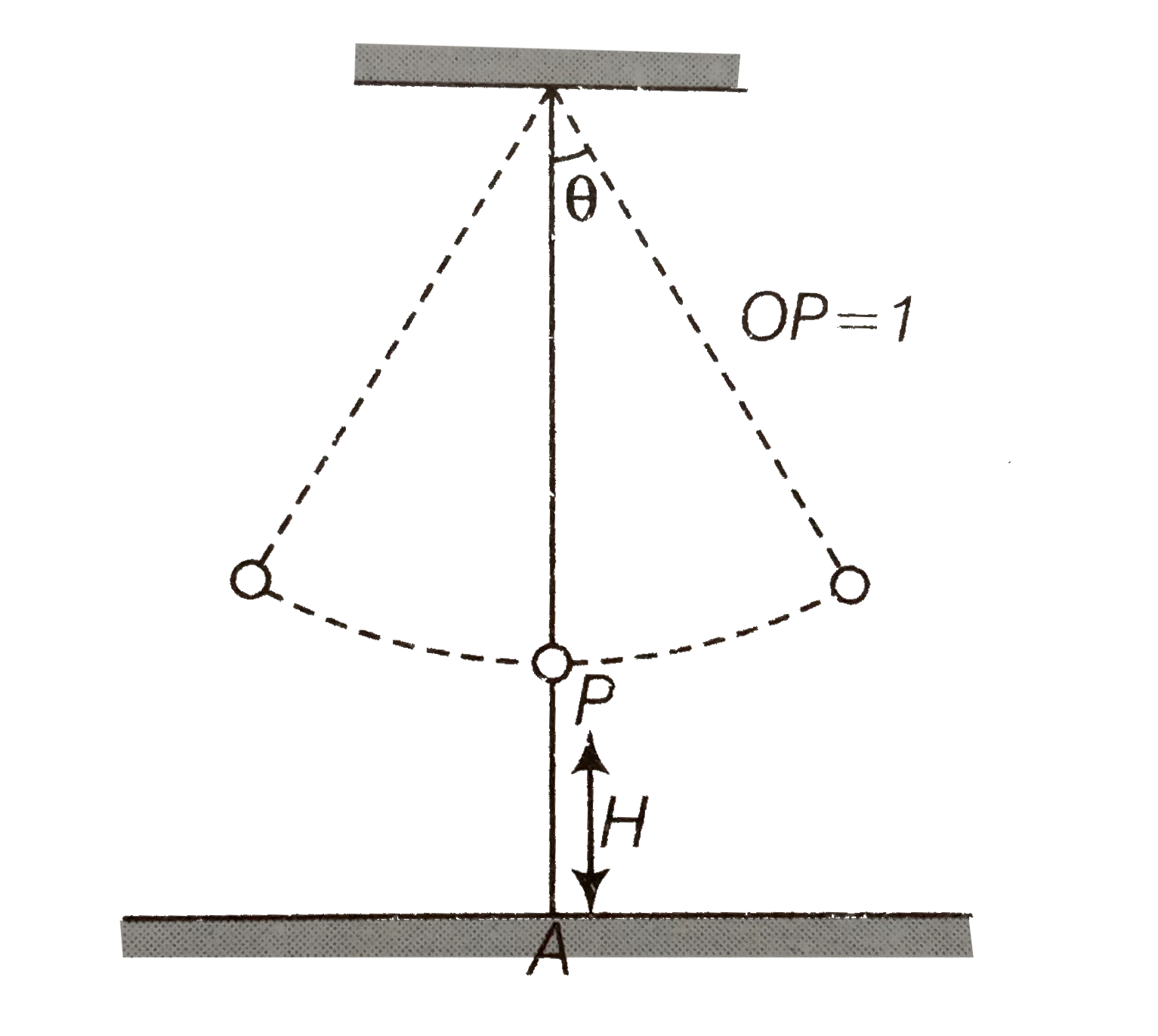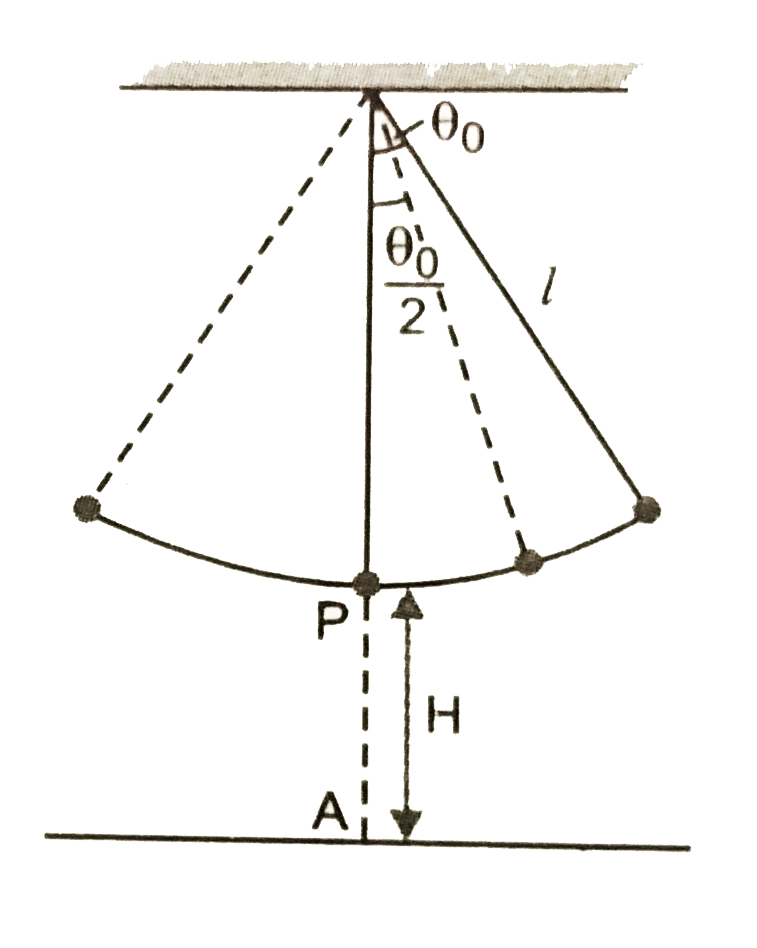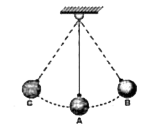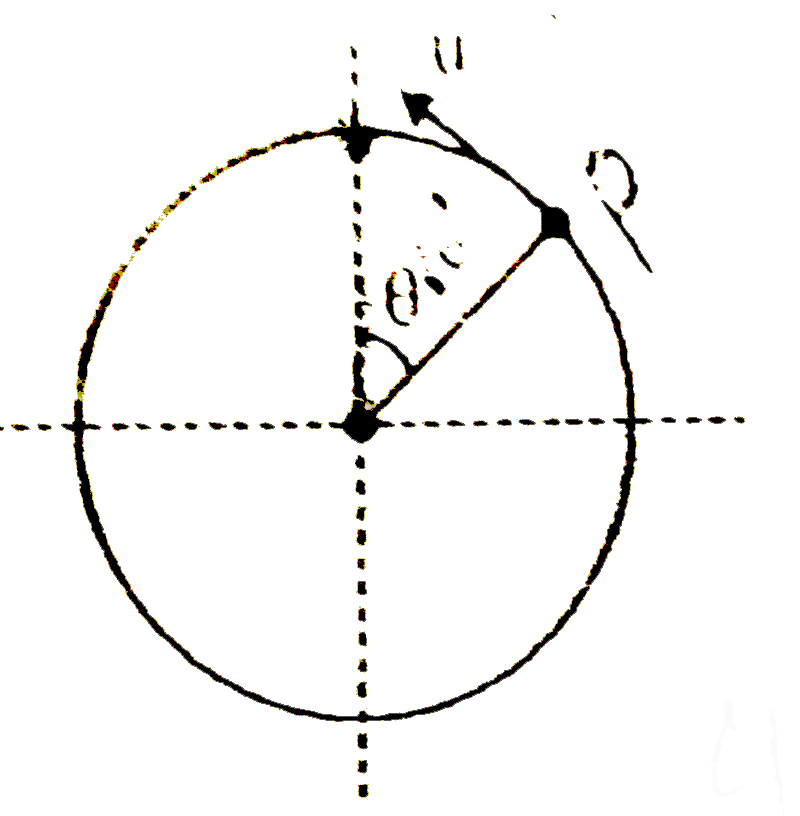A simple pendulum of time period 1s and length l is hung from a fixed support at 0. Such that the bob is at a distance H vertically above A on the ground (figure) the amplitude is θ0 the string snaps at 0=θ0/2. Find the time taken by the bob to hit the ground. Also find distance from A where bob hits the ground. Assume θ0 to be small, so that sinθ0≈θ0andcosθ0≈1.

Here, θ0 is the angular amplitude of simple pendulum and time period, T=1s. The angular displacement of the bob of the pendulum at any inisant t is given by
θ=θ0sinωt=θ0sin(2πT)t
=θ0sin(2π1)t=θ0sin2πt ..(i)
(∵T=1s.)
At time t1, let θ=θ0/2 then from (i), we have
θ02=θ0sin2πt1 or 2πt1=π6ort1=112s
Differentiating (i) w.r.t. t, we have
dθdt=2πθ0cos2πt
When t=t1=112, then dθdt=2πthet0cos2π×112=2πθ0×√32=√3πθ0
Angular velocity of the bob of simple pendulum is ω=dθdt=√3πθ0
velocity of the bob of simple pendulum, v=rω=lω=l(√3πθ0)
It is acting perpendicular to string.
The vertical component velocity of bob, vy=vsin(θ0/2)=l√3πθ0sin(θ0/2)
Horizontal component velocity of bob, vx=vcos(θ0/2)=l√3πθ0cos(θ0/2)
The height of the bob when the pendulum snaps is , H′+H+lcos(θ0/2)=H+l[1−cos(θ0/2)]
If t' is the time taken by the bob to fall through height H(') , then using the relation , S=ut+12at2,
we have s=H′,u′=vy=l√3πθ0sin(θ0/2),t=?
∴H′=[√3πθ0lsin(θ0/2)]t+12gt2
or t2+[2√3πθ0lsin(θ0/2)g]t−2H′g=0
∴t=−[2√3θ0lsin(θ0/2)g]±√[12π2θ20l2sin2(θ0/2)g2]+4×2H′lg2
=−[√3πθ0lsin(θ0/2)]±√3π2θ20l2sin2(θ0/2)+2H′gg
=−√3π(θ0/2)±√3π2θ20(θ20/4)+2H′gg
As θ0 is small so the terms with θ20 beign very very small can be neglected.
∴t=√2H′gg=√2H′g
Now, H′=H+l−l×l=H [∵cos(θ0/2)=1]
∴t=√2H′g=√2Hg
The horizontal distance travelled by bob after snapping
x=vxt=[√3lπθ0cos(θ0/2)]√2Hg=√3lπθ0×1×√2H/g=√6Hg×θ0lπj
At the time of snapping, the horizontal distance of the bob from point A is =lsin(θ0/2)=lθ0/2
Thus the distance of bob from A where it meets the ground is
=lθ02−√6Hglπθ0=lθ0[12−π√6Hg

Topper's Solved these Questions
- BOOK - PRADEEPCHAPTER - OSCILLATIONS AND WAVESEXERCISE - Advanced Problems For Competitions20videos
OSCILLATIONS AND WAVES
- BOOK - PRADEEPCHAPTER - OSCILLATIONS AND WAVESEXERCISE - NCERT EXERCISES WITH SOLUTIONS19videos
OSCILLATIONS AND WAVES
- BOOK - PRADEEPCHAPTER - OSCILLATIONS AND WAVESEXERCISE - Short Answer Questions104videos
OSCILLATIONS AND WAVES
- BOOK - PRADEEPCHAPTER - MATHEMATICAL TOOLSEXERCISE - Fill in the blanks5videos
MATHEMATICAL TOOLS
- BOOK - PRADEEPCHAPTER - PHYSICAL WORLD AND MEASUREMENTEXERCISE - Competiton Focus Jee Medical Entrance18videos
PHYSICAL WORLD AND MEASUREMENT
Similar Questions
A simple pendulum of time period 1s and length l is hung from a fixed support at 0. Such that the bob is at a distance H vertically above A on the ground (figure) the amplitude is θ0 the string snaps at 0=θ0/2. Find the time taken by the bob to hit the ground. Also find distance from A where bob hits the ground. Assume θ0 to be small, so that sinθ0≈θ0andcosθ0≈1.
 View Solution
View SolutionIn the figure, if the time taken by the bob to move from A to B is 0.5 second, the time period of the pendulum is____
 View Solution
View Solution
Knowledge Check
- Question 1 - Select One
A ball is thrown upwards with a speed u from a height h above the ground.The time taken by the ball to hit the ground is
A√2h/gB√8h/gC√u2+2ghgDug+√2hg - Question 2 - Select One
If a simple pendulum of length l has maximum angular displacement θ, then the maximum velocity of the bob is
A√LgB2√glsin(θ2)C√2glsinθD√2gl - Question 3 - Select One
A simple pendulum of length l is set in motion such that the bob, of mass m, moves along a horizontal circualar path , and the string makes a constant angle θ with the vertical. The time period of rotation of the bob is l and the tension in the thread is T
At=2π√l/gBt=2π√lcosθ/gCT=4π2mlt2DThe bob is in equilibrium
A simple pendulum is constructed by attaching a bob of mas m to a string of length L fixed at its upper end. The bob oscillates in a vertical circle. It is found that the speed of the bob is v when the string makes an angle θ with the vertical. Find the tension in the string at this instant.
View SolutionA pendulum bob of mass m and length L is released from angle θ with the vertical. Find
(a) the speed of the bob at the bottom of the swing and
(b) tension in the string at that timeView SolutionA simple pendulum of length l has a maximum angular displacement θ. The maximum kinetic energy of the bob of mass m will be
View SolutionA simple pendulum of length l has maximum angular displacement θ . Then maximum kinetic energy of a bob of mass m is
View SolutionA simple pendulum bob of mass M and length l has one of its end fixed at the centre of a vertical circle as shown in figure. If θ=60∘ at the point P, the minimum speed u that should be given to the bob so that it completes vertical circle is :
 View Solution
View Solution

